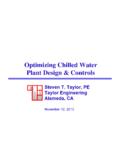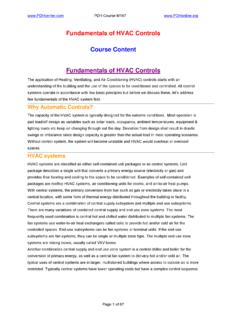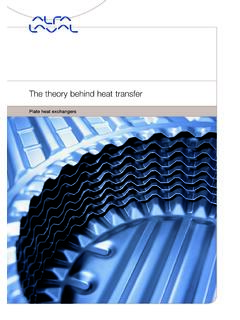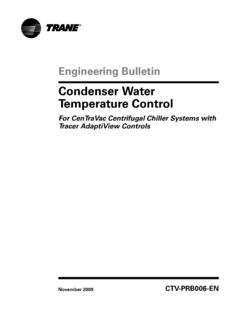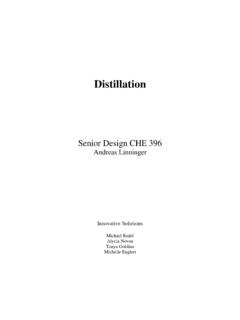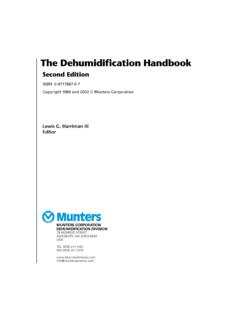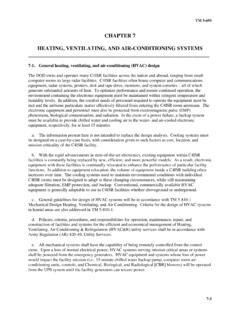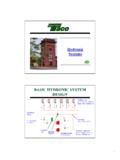Transcription of Wind Turbine Design - NREL
1 Technische Universit t M nchen Wind Energy Institute Wind Turbine Design Origins of Systems Engineering and MDAO for Wind Energy Applications Carlo L. Bottasso Technische Universit t M nchen, Germany WESE Workshop, Pamplona, Spain, 2-3 October 2019 Design Optimization of Wind Turbines Outline Some technical reasons behind the falling prices of energy from wind Multidisciplinarity and the need for MDAO MDAO tools: architectures, methods, limits and gaps Conclusions and outlook Design Optimization of Wind Turbines Design Trends Higher tower higher wind speed because of vertical shear Larger swept area larger power capture Improved capacity factor lower CoE Reducing specific power, size grows more than power rating (Source: IEA Wind TCP Task 26) Data for onshore turbines 1MW Design Optimization of Wind Turbines Why?
2 Increasing A Decreasing Rated power: = Rated wind speed = Since can not be drastically increased, the most effective way to decrease is to reduce specific power (or power loading) More time spent in region III at full power, increased capacity factor Design Optimization of Wind Turbines Design Trends & Challenges Size Weight (Cost) Grows as size3 (but AEP only as size2) Technological innovation (source: LM Wind Power) Larger machines can not be designed by simple upscaling of smaller ones, to avoid cubic law of growth: need for R&D and technological innovation Design Optimization of Wind Turbines Some Present and Future Technological Innovations that Enable Upscaling Each innovation will come with pros and cons Systems engineering -the final judge Nice idea, but does it reduce CoE?
3 -: Design Optimization of Wind Turbines 1970 2019 WTS-4 (4 MW) Hamilton Standard, 1982 MOD-5B ( MW) Boeing, 1987 V164 Vestas 8MW 2016 2017 V10 (30 kW) Vestas, 1979 Siemens 2017 (in part from G. van Kuik, TUDelft) HALIADE-X 12MW 220m GE 2021 How Did We Get Here? 12 MW 10 kW V164 Vestas 8MW 2016 2017 Siemens 2017 HALIADEX 12MW 220m GE 2021 Boeing, 1987 Just Compare the Blades! Design Optimization of Wind Turbines12 MW 1970 2019 MOD-5B ( MW) 10 kW V10 (30 kW) Vestas, 1979 ---Airfoils Add-ons Solidity Shape Materials Technische Universit t M nchen Wind Energy InstituteMultidisciplinarity & Couplings and the Need for MDAO nd Design Optimization of Wi Turbines-Loads: envelope computed from large number of Design Load Cases (DLCs, IEC-61400) -Fatigue (25 year life), Damage Equivalent Loads (DELs) -Maximum blade tip deflections -Placement of natural frequencies wrt rev harmonics -Stability.
4 Flutter, LCOs, low damping of certain modes, local buckling -Complex couplings among rotor/drive-train/tower/foundations (off-shore: hydro loads, floating & moored platforms) -Weight: massive size, composite materials (but shear quantity is an issue, fiberglass, wood, clever use of carbon fiber) -Manufacturing technology, constraints -Generator (RPM, weight, torque, drive-train, ..) -Pitch and yaw actuators -Brakes GE wind Turbine (from ) Pitch-torque control laws: -Regulating the machine at different set points depending on wind conditions -Reacting to gusts -Reacting to wind turbulence -Keeping actuator duty-cycles within admissible limits -Handling transients: run-up, normal and emergency shut-down procedures -Annual Energy Production (AEP) -Noise -Transportability nd computed number ofCases (DLFatigueDamage LoadsMaximudeflectionPlacemfrequenciehar monicsStability.)
5 TuatorsGE wind Turbine (from ) Design Optimization of Wi Turbines-Loads: envelope from large Design Load Cs, IEC-61400) -(25 year life), Equivalent (DELs) -m blade tip s -ent of natural s wrt rev -flutter, LCOs, low damping of certain modes, local buckling -Complex couplings among rotor/drive-train/tower/foundations (off-shore: hydro loads, floating & moored platforms) -Weight: massive size, composite materials (but shear quantity is an issue, fiberglass, wood, clever use of carbon fiber) -Manufacturing technology, constraints -Generator (RPM, weight, torque, drive-train -Pitch and yaw ac -Brakes Pitch-torque control laws: -Regulating the machine at different set points depending on wind conditions -Reacting to gusts -Reacting to wind turbulence -Keeping actuator duty-cycles within admissible limits -Handling transients: run-up, normal and emergency shut-down procedures -Annual Energy Production (AEP) -Noise -Transportability Warning.
6 Strong couplings Potentially expensive (one load assessment: 107 108 time steps) Baseline Design by consortium 1. Perform purely aerodynamic optimization for max(AEP) 2. Follow with structural optimization for minimum weight Design Optimization of Wind Turbines A Simple Example: Aero optimum Structural optimum Example: 10 MW (class 1A, D= , H=119m) Dramatic reduction in solidity to improve AEP leads to large increase in weight CoE increases (+ ) Spar cap Chord Design Optimization of Wind Turbines Optimization-Based Design of WTGs Requirements for multi-disciplinary optimization tools: Be fast (hours/days) (on standard hardware!)
7 Pre-MDAO approach to Design : discipline-oriented specialist groups Different simulation models Lengthy loops to satisfy all requirements/constraints (months) Data transfer/compatibility among groups Provide solutions in all areas (aerodynamics, structures, controls, sub-systems) for specialists to refine/verify Account ab-initio for all complex couplings (no fixes a posteriori) Use fully-integrated tools (no manual intervention) MDAO will never replace the experienced designer! .. but greatly speeds up Design , improves exploration/knowledge of Design space Design Optimization of Wind Turbines Literature Integrated tools: ECN: FOCUS (Duineveld, 2008) DTU: -HAWTOPT (D ssing, 2011) -New Design framework by M.
8 McWilliam nrel & Sandia: WISDEM (Dykes et al., 2014) POLIMI & TUM: Cp-Max (with A. Croce, P. Bortolotti & many others) -Begin in 2007 thanks to grant from TREVI Energy Spa -First presentations to industry from 2008 onwards -First conference presentations from 2009 onwards (EACWE 2009) -Papers: Bottasso et al., 2012-2015; Croce et al. 2016, Sartori et al. 2016, Bortolotti et al. 2016-19 Several proprietary tools at various companies Technische Universit t M nchen Wind Energy InstituteWhat Does a Typical MDAO Tool Look Like? 2D FEM sectional model Blade and tower beam models Structural Design parameters Aeroservoelastic multibody model Aerodynamic Design parameters Constraints: Max tip deflection Ultimate & fatigue loads Natural frequencies Buckling Manufacturing constraints Geometric constraints Noise.
9 Optimizer min Cost wrt Design variables subject to constraints Control systems Load & performance analysis: DLCs AEP Campbell Noise .. Cost model(s) Configurational Design parameters Sub-systems Generator Nacelle cooling Pitch Brake .. 2D FEM sectional model Blade and tower beam models Structural Design parameters Aeroservoelastic multibody model Aerodynamic Design parameters Constraints: Max tip deflection Ultimate & fatigue loads Natural frequencies Buckling Manufacturing constraints Geometric constraints Noise .. Optimizer min Cost wrt Design variables subject to constraints Control systems Load & performance analysis: DLCs AEP Campbell Noise.
10 Cost model(s) Configurational Design parameters Sub-systems Generator Nacelle cooling Pitch Brake .. Design variables: Configurational Aerodynamic Structural Materials Sub-systems Controls .. tion of Wind Design Optimiza Turbines Some Design parameters have very minor effects on CoE Problem may be ill-posed Expensive performance analysis has to be repeated for each change in each Design variable Possibly non-smooth load behavior (DLC jump) 2D + beam models unable to capture local 3D effects Various possible algorithmic flavors: Monolithic Iterative Partitioning of vars Surrogate models Global/local opt.










